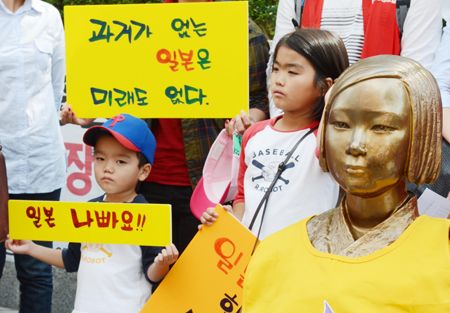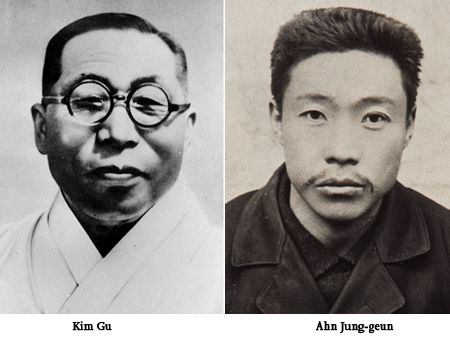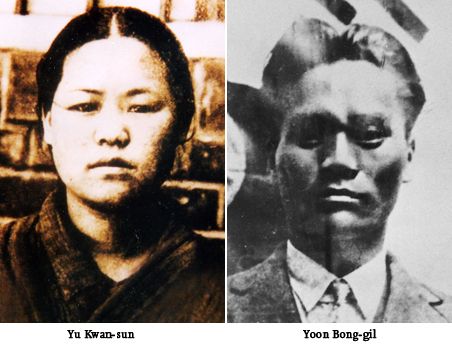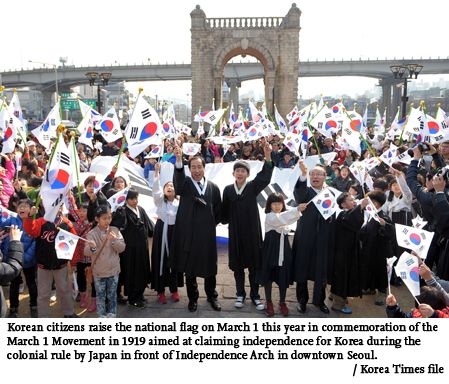Darkest days in Korean history

Children hold boards decrying Japan’s failure to repent for sexual slavery during its rule of Korea next to the comfort women statue during a Wednesday rally in front of the Japanese Embassy in central Seoul. The boards read: “Japan is bad” and “Without its past, Japan does not have a future.” The rally takes place every Wednesday next to the statute, which Japan has asked to be removed. / Korea Times file
People suffered greatly under brutal Japanese colonial rule
This is the ninth of a 10-part series of Korean history from its mythological, ancient beginning until the present day. This project is sponsored by several companies and public agencies including Merck Korea, eBay Korea, Daewoo Securities and Korea Post. ― ED.
The first half of the 20th century was definitely one of the gloomiest and darkest periods for the Korean people because they suffered greatly under the colonial rule of imperial Japan.
Faced with the military might of Japan, Joeson Kingdom, which had remained intact for five centuries, collapsed and the people had to accept the authority of the illegal colonial government against their will.
Irrespective of gender, many Koreans experienced forced conscription during World War II ― men were used as cannon fodder, while women were brutally abused as sex slaves, something the Japanese government was fully aware of.
But Koreans did not sit idle. They organized many peaceful movements, as well as armed campaigns in efforts to regain their independence. However, it was three and a half decades before Japan was eventually defeated by the Allies in 1945.
Historians have yet to reach a consensus about the years of Japanese rule. Some controversial reports argue that the 35-year-period was actually helpful for Korea, laying a solid foundation for the nation’s rapid economic growth in the latter half of the 20th century.
By contrast, many Korean and foreign experts flatly rebuff such views as groundless claims which attempt to idealize imperialism, while overlooking the dire conditions Koreans lived through during this bleak period.
Time of darkness
As Japan’s military strength grew, it won wars against both China and Russia, and made no secret of its desire to control Korea in the late 19th and early 20th century. In 1905, it declared Korea as its protectorate, robbing Korea of her sovereignty, before imposing complete annexation five years later.
The 1910 Annexation Treaty was legally void from the very beginning because it was transacted under threat of force and King Sunjong, the last ruler of Joseon, refused to sign it. Instead, it was signed by the Prime Minister Lee Wan-yong.
Throughout the 1910s, the Japanese administration resorted to repressive measures that were enforced by its military policemen who often flogged Koreans without any reason to do so.
Under the control of its military police force, the Japanese Resident-General took charge of the Korean government and its administration, while freedom of speech, the press and the right of assembly were outlawed.
The iron-fisted rule showed some sign of easing after the March 1st Movement of 1919 when a declaration of independence was read in Seoul and millions of Koreans, men and women, took part in peaceful anti-Japan rallies all over the peninsula.
Mortality tables from Korea and Japan demonstrate different figures, but during the 12-months of rallies, many thousands of Koreans are believed to have been killed and far more were tortured and imprisoned. Many were teenagers, and many others were women such as Yu Kwan-sun.
Thereafter, Japan somewhat relaxed its autocratic rule because international newspapers reported on the harsh treatment of Koreans in the aftermath of the March 1st Movement. The Japanese government came up with a few appeasement policies such as permitting Korean-language newspapers although these were still heavily censored. While education was also expanded, it promoted the Japanese language at the expense of Korean. Korean intellectuals such as Shin Chae-ho attempted to preserve Korea’s identity by setting up societies to research and promote Korean history, as well as the Korean language. Others formed military groups, considering this to be the only way to bring independence to Korea.
This time of appeasement soon passed as Japan set about expanding its colonial rule over the rest of Asia. And matters became much worse in the late 1930s and early 1940s.
Koreans were ordered to take Japanese names and the few Korean-language media outlets were shut down. In addition, many of Korea’s cultural artifacts were removed or destroyed. The Korean language was eventually banned entirely just as the Irish language had been banned by the British during its harsh colonial rule of Ireland, which lasted hundreds of years.
Korean men were drafted into the army or put into forced labor ― many were sent to Japan where they were harshly discriminated against. Women were no exception because many were dispatched to war fronts where they suffered daily sexual abuse from the Japanese military in what is surely one of the worst cases of sex-trafficking in modern history. Millions of Koreans were estimated to be conscripted in one way or another and many never returned to their homeland.
Some Japanese historians and politicians contend that Koreans participated in the military voluntarily and that no women were put into sexual slavery at all. Such claims continue to cause serious diplomatic problems between both countries. An additional issue is that the abused women were raped and assaulted but unacceptably, described as “comfort women.” The few remaining survivors protest peacefully every Wednesday outside the Japanese Embassy in Seoul seeking the atrocities they experienced to be recognized by Japan.
While the Japanese government has expressed regrets for its past wrongdoings, several politicians have made inflammatory comments, generating great uproar in Korea.
A major bone of contention is Dokdo, Korea’s easternmost islets to which Japan also claims sovereignty. The islands have been recognized as part of Korea in historical records dating from the sixth century as discussed earlier in this series. Dokdo is currently under the strict control of Korea with members of the national police stationed there but Japan continues to claim sovereignty over the islets, which leads to resentment among Koreans who perceive this to be a negative legacy of Japan’s colonial rule. Currently China is also having disputes with Japan over the Diaoyu Islands, known as the Senkaku Islands in Japan.
Tragic Times
As demonstrated by the March 1st Movement of 1919, which took place on King Gojong’s death, Koreans did not remain on the sidelines and many risked their lives to put an end to the Japanese occupation and regain independence.
A nationwide peaceful demonstration erupted once again on June 10, 1926 on the death of King Sunjong, the last monarch of the Joseon Kingdom, and anti-Japanese rallies were organized in 1929 with students in Gwangju taking the lead.
In Shanghai, national leaders set up the Provisional Government of the Republic of Korea in April 1919, a month after the March 1st Movement. The Korean Liberation Army, siding with allied forces, declared war against Japan in 1941 under the stewardship of nationalist leader Kim Gu.
Korean volunteer armies fought against Japanese combatants mostly in Manchuria, while guerilla groups created much trouble for the Japanese authorities on the Korean peninsula and in China.
Two independence fighters stood out. Ahn Jung-geun was a young Catholic who in 1909 assassinated Hirobumi Ito, a Japanese statesman who spearheaded Japan’s annexation of Korea.
The other is Yun Bong-gil who in 1932 staged an attack with a bomb disguised as a lunch box at a Japanese army celebration of Emperor Hirohito’s birthday in Shanghai, killing several high-ranking Japanese military figures.
From the perspective of Japanese rulers, both Ahn and Yun were considered terrorists but for Koreans, they are considered national heroes who sacrificed their lives for the cause of their country’s independence.
Throughout the 35 years of colonial rule, Koreans regularly faced Japanese brutalities and in particular, insurgents and those who hid rebels faced harsh treatment such as torture, but were often executed.
One of the most notable examples of the brutality Koreans faced happened in April 1919 in Jeam-ri, south of Seoul where Japanese soldiers gathered around 30 residents of the village in a church and then burned it to the ground. The massacre was reported to the outside world by a Canadian missionary, Frank William Schofield, generating an international outcry.
Without Schofield, the first foreigner who was buried at Seoul National Cemetery, the Jeam-ri massacre might have passed unnoticed and forgotten by history.
Korea gains independence
Japan drew the United States into World War II by attacking Pearl Harbor in 1941. In the beginning, its surprise attack and some other strategic victories led the Japanese to believe they were invincible ― they had already won wars against China and Russia.
But Japan’s victorious campaign soon ended when it suffered a series of setbacks starting midway through 1942 as Japan lost control over airfields in Saipan and Guam, which enabled Allied forces to bombard Japan.
The dropping of two nuclear bombs at Hiroshima and Nagasaki and the horrendous devastation that followed forced its military leaders and the emperor to admit defeat so that World War II finished, and Korea gained its long-awaited independence on Aug. 15, 1945, now celebrated every year as Liberation Day.
Dr. Kevin N. Cawley is currently the Director of the Irish Institute of Korean Studies at University College Cork (UCC), Ireland _ the only institute in Ireland dedicated to promoting Korean studies ― funded by the Academy of Korean Studies, South Korea. He was previously a Gyujanggak Fellow at Seoul National University.
In Detail
March 1st Movement of 1919:
It was one of the earliest and biggest public displays of Korean resistance toward Japan, which occupied Korea in 1910. The movement, which took place on March 1, 1919 after the death of King Gojong, was organized as a peaceful campaign participated in by millions of Koreans.
King Gojong (1852-1919):
The penultimate monarch of the Joseon Kingdom who saw the collapse of the 500-year-old dynasty
King Sunjong (1874-1926):
The last emperor of the Joseon Kingdom
Yu Kwan-sun (1904-1920):
Is a student and organizer of the March 1st Movement against the Japanese colonial rule of Korea. With deep faith in God, she had the courage to act boldly to stand against colonial rule at the risk of her own life.
Lee Wan-yong (1858-1926):
Is a pro-Japanese minister of Korea, who signed the Annexation Treaty between Japan and Korea in 1910. He is regarded as one of the most notorious traitors among the Korean people.
Shin Chae-ho (1880-1936):
Is a Korean independence activist and historian. He also founded the nationalist historiography of the country. He is famous for claiming that Manchuria is linked to Korea’s ancient past.
Dokdo:
A group of small islets in the East Sea (Sea of Japan). Situated some 90 kilometers east of Korea’s Ulleung Island and 160 kilometers northwest of Japan’s Oki Island, Dokdo is a set of volcanic outcrops whose ownership has been disputed between Seoul and Tokyo over the past several decades.
Kim Gu (1876-1949):
As a Korean leader of the country’s independence movement against Japan, Kim became the last president of the Provisional Government of the Republic of Korea and declared war against Japan in the 1940s. He is better known as his penname of Baekbeom.
Ahn Jung-geun (1879-1910):
A Korean independence activist who in 1909 assassinated Ito Hirobumi who played a major role in Japan’s annexation of Korea
Yun Bong-gil (1908-1932):
A Korean independence activist who carried out a bombing attack in China killing and injuring several of Japan’s military leaders who gathered in Shanghai on April 29, 1932 to celebrate Emperor Hirohito’s birthday <The Korea Times/Kim Tae-gyu and Kevin N. Cawley>

























































